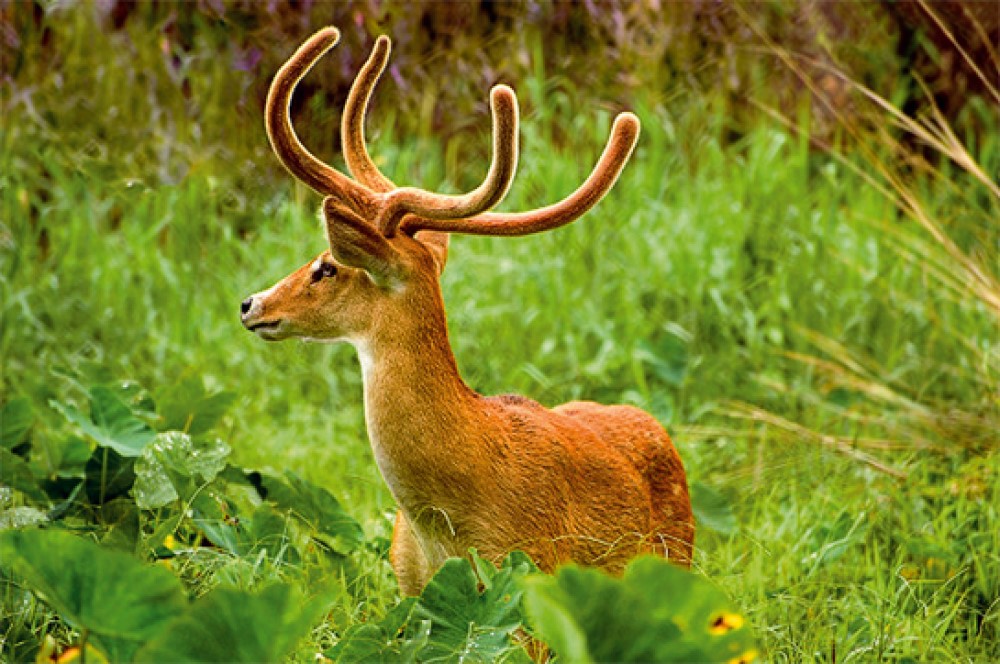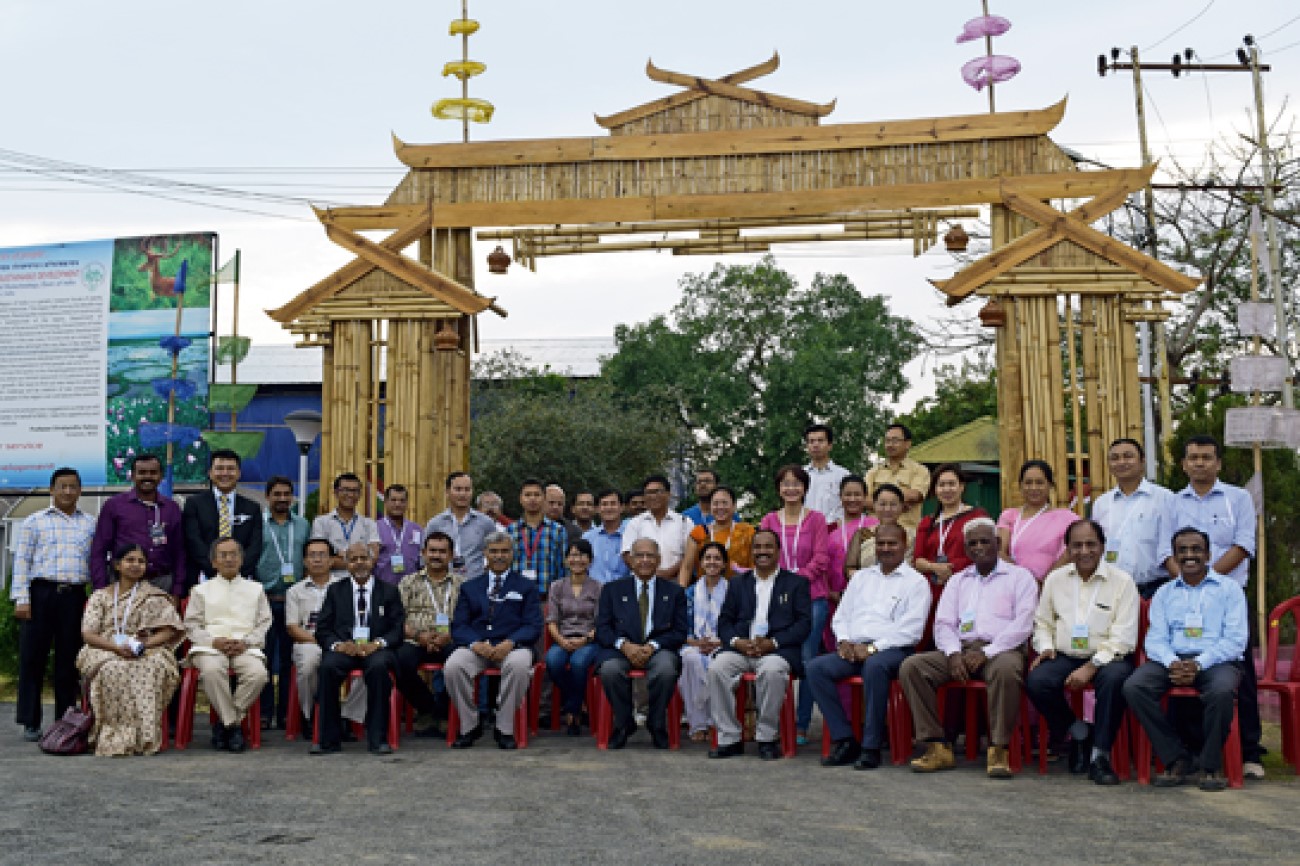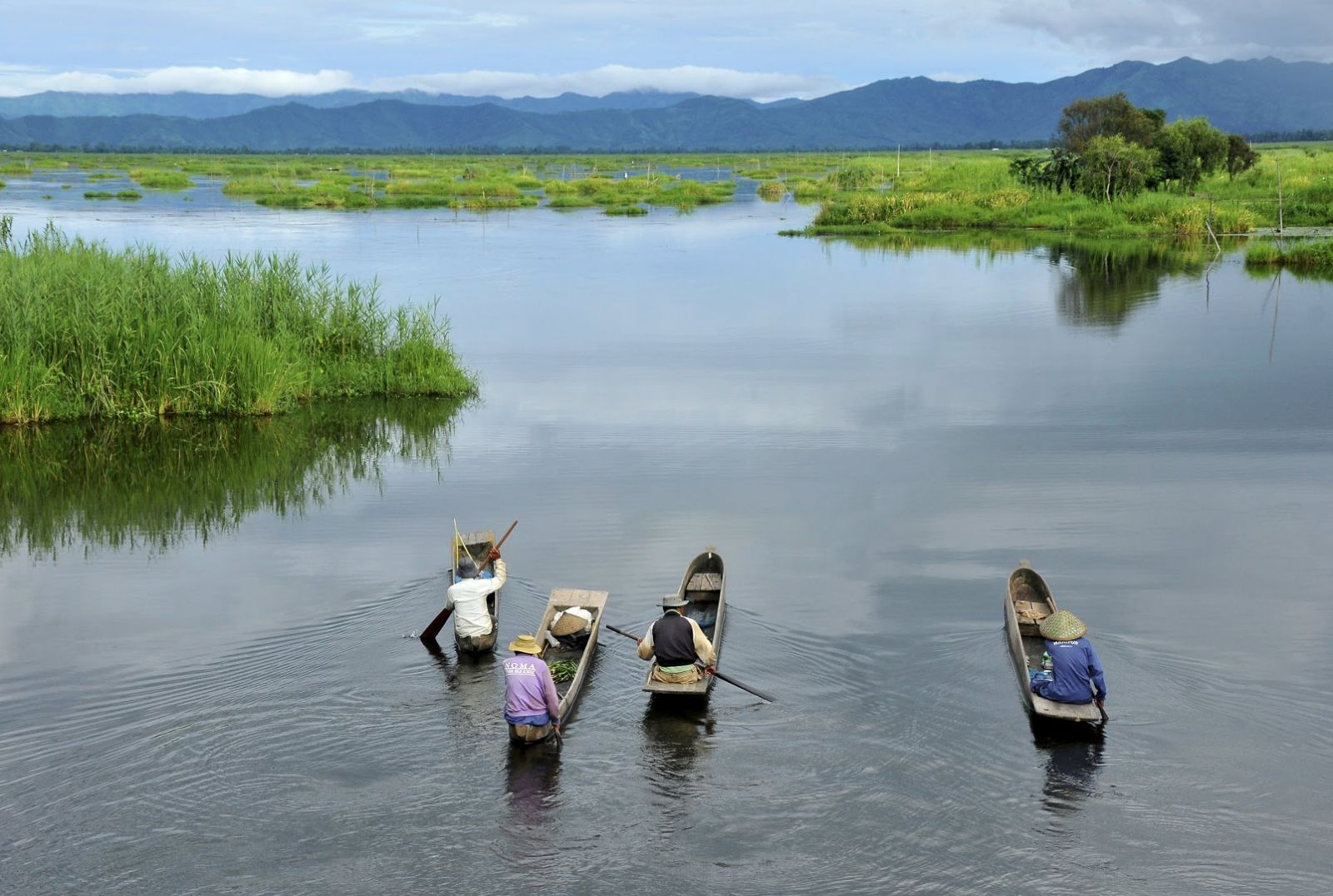Hope Floats
First published in Sanctuary Asia,
Vol. 35
No. 6,
June 2015
By Cara Tejpal
Dr. A.J.T. Johnsingh leans across his colleague Professor Mewa Singh to peer at me. “You know," he says, “When a pack of dholes bring down a stag in velvet, they crunch up its antlers like they're biscuits." Having delivered this piece of trivia he settles back down in his seat and waits as I fumble for an appropriate response. Around us, a platoon's worth of gun-wielding security personnel pace the temporary but beautiful conference hall at the Institute of Bioresources and Sustainable Development (IBSD), where we await the arrival of Okram Ibobi Singh, the Chief Minister of Manipur.
It's a pleasant April morning in Imphal, and I am here on the invitation of the institute to attend a national workshop on the conservation of a benign ungulate species known as the brow-antlered deer or sangai. Just an hour's drive from IBSD, confined to a wretchedly small parcel of unique habitat, lives the last remaining population of these deer in the world. Here, in the 40 sq. km. Keibul Lamjao National Park, this sub-species of Elds deer Rucervus eldii eldii quietly persists even as the threats around them steadily close in. A critically endangered, endemic, large mammal, you would expect the sangai to feature on the priority list of every government and non-governmental wildlife agency worth its salt, but the species has been largely ignored for decades, overlooked in favour of rhinos, bustards, tigers, elephants and other less endangered but more ‘charismatic' animals.
Yet one ‘Lone Ranger' has, for close to 40 years, consistently extended a lifeline to the species, while awaiting the awakening of authorities to its perilous status. Dr. M.K. Ranjitsinh hopes that today is that day. In the very first session of the workshop he critiques the population figure proposed by the state. His voice booms across the room, “Please underestimate the population!" he urges. “Ground surveys are not completely accurate. It is better that we err on the side of caution."
Ranjitsinhji has good reason to worry. In 1975, it was he, as India's Director of Wildlife that boarded a helicopter to conduct an aerial survey of Keibul Lamjao and in doing so discovered that poaching and habitat destruction had decimated sangai populations. Only 14 animals remained on earth. Subsequently, the national park was notified, the sangai received much-needed attention, and slowly made a recovery to its present numbers. But then it rapidly faded from conservation discourse. Back in the 70s, the situation was dire, but the threats were more manageable. Today, while the sangai population has risen to just over 200 individuals, the threats have diversified and evolved in complexity.

Photo: Ranjit Moirangthem.
What makes the sangai so vulnerable is that it is a habitat specialist. They live exclusively on floating islands of decaying biomass and growing vegetation, known as phumdis, on one end of Manipur's Loktak Lake, separated from it by a mere strip of land. It is into this lake that the untreated sewage from Imphal city drains. And it is this lake whose hydrology is subject to a game of Russian roulette by the Ithai barrage of the 105 MW Loktak-hydroelectric project (“Is the only purpose of water to provide electricity?" asks Ranjitsinh) that dictates its water levels and therefore the strength of the phumdis. It is this lake that is being choked by illegal reclamation. And it is this very lake on which a growing number of Manipuris depend for both fish and wild vegetation.
In the course of her research on the people-park dynamic of Keibul Lamjao in 2008, Dr. Ruchi Badola, a scientist with the Wildlife Institute of India, found that 58 per cent of the people who used the park's resources were entirely dependent on it for their livelihood and that there was a 40 per cent overlap in the preferred vegetation extracted by the people and deer.
If these stifling anthropogenic pressures were not enough, the sangai, unlike other endangered species, has not even been afforded the luxury of a safety net in the form of a healthy captive population, or a second home. Somewhere along the way of a series of transfers of four deer from the wild to the Kolkata zoo, to the Delhi zoo and back to the Manipur zoo, it is thought that they were crossed with another sub-species of Elds deer known as the thamin, native to Myanmar and Thailand. With suspicions rife that the existing captive population of sangai is of ‘mixed descent and that too from a miniscule gene pool of just four deer, release into the wild is out of the question. An authority on the captive management of wild animals and a professor with the University of Mysore Prof. Mewa Singh agrees, “Most zoo-bred deer suffer tuberculosis. Our zoos aren't able to keep them free from pathogens and management practices are, for the most part, abysmal. Captive breeding is a science that India has not yet perfected."

Photo courtesy: Institute of Bioresources and Sustainable Development.
But Dr. G Umapathy, a senior scientist with the Hyderabad-based Laboratory for the Conservation of Endangered Species (LaCONES), is more optimistic. Exploring the next frontier in wildlife conservation - conservation physiology, he is brimming with energy as he speeds through his talk, promising that in his laboratory he can unlock infinite secrets from animal faeces. A few samples from the captive sangai are all he needs to determine their ‘purity and ex-situ conservation is not out of the question. “Globally, 19 species, of which seven were extinct in the wild, have been successfully reintroduced," he asserts. It seems that solutions do exist.
The next morning, I find myself in a traditional canoe, being steered by a forest guard through the narrow water channels of Keibul Lamjao. Sitting uncomfortably behind me, umbrella flowering above his head in defense against a persistent drizzle, is Professor Dinabandhu Sahoo, the Director of IBSD. Six months ago when he arrived in Imphal, Prof. Sahoo had never heard of a sangai. As the craft brushes against the surrounding phumdis and lurches alarmingly with every pull of the guards bamboo pole, Prof. Sahoo laughs in self-deprecation.
DEER COUSINS
Like the sangai,
Kashmir's red deer, the hangul, is today restricted to a single, persecuted population in the Dachigam National Park. The 200 odd hangul that remain, face stiff competition from a state-run sheep farm for rights over their grazing meadows. This sheep farm has been illegally operating inside Dachigam since 1978, despite repeated directives from the Chief Ministers office to clear out of the National Park.
The hardground barasingha or swamp deer on the other hand is making a hesitant recovery. In the 1960s, a single population of 66 deer in the Kanha National Park was all that remained. But today, thanks to the determination of good wildlife managers, their numbers have rebounded and seven individuals have been translocated to a new home in the Van Vihar National Park in the interest of maintaining a second, viable population of the species.
"They celebrate the Sangai Festival in Imphal. It's not about conservation, but it is named after the deer. When I first heard about it, I thought it was called the Shanghai festival and wondered why we were celebrating a Chinese city! When I finally found out that the sangai was an endemic, endangered species, I conceptualised the workshop and decided that it was time to get things moving."
The Sangai Festival isn't the only thing to have derived its name from this unassuming deer. The newspaper delivered to my hotel room that morning was titled The Sangai Express, and scattered across Manipur are towns and villages with names like Sangaikot, Sangaithel and Sangaiprou. The people indisputably share a close bond with the sangai, a fact that reflects brightly in the data collected by, you best believe it, Dr. Sanggai Leima who completed her Ph.D. under the guidance of Dr. Badola. Each member of the 249 households that she surveyed around the national park agreed that protected area status was necessary for the conservation of the deer and a surprising 70 per cent agreed that resource extraction should be controlled.
When we alight from our canoes to begin our ascent to the top of Pabot Hill from where we hope to glimpse the brow-antlered deer, I get the distinct feeling that we are on terra ‘unfirma. With each step, my feet sink a few inches into the ground and my shoes fill with water. The experience greatly increases my respect for the hooves and gait that the sangai have evolved to allow them unhindered movement on their floating homes and that has given them the epithet, ‘the dancing deer'.

Photo: Samsul Huda Patgiri.
In theory, conserving the sangai and its habitat should be profoundly easy. Preserving 40 sq. km. of land and lake are not much to ask for the survival of an entire species, but the stakeholders are so many and so disconnected from one another that in practice sangai conservation is daunting. Between the Forest Department, independent researchers, scientists, the Loktak Lake Authority, local villagers, the National Hydroelectric Power Corporation and the IBSD, suggestions are plentiful, but a concerted strategy is yet to materialise. Incredibly, where the tiger and elephant have become money-spinners through tourism, the sangai receive no more than half-a-dozen visitors a year. An astonishing fact when you consider that they are the last of their kind, persisting on truly one of the most unique landscapes that I have yet had the privilege to visit.
From the top of the hill, the phumdis fan out around us like an expansive watercolour. With the ominous grey dome of the sky above us, and the canoes bobbing lazily in the distance, the scene is dramatic. Patiently we wait, and our virtue is rewarded. Amidst gasps of delight a participants keen eye spots a hind with a young one-two chocolate smears against the jade grass. Ten minutes later on another phumdi, a stag appears. Handsome and dignified, it halts in a clearing and turns its impressive U-shaped antlers towards us. It is then that I am hit with the overwhelming knowledge that I am one of just a handful of people to have actually seen a sangai deer in the wild. Sighting a sangai has none of the adrenalin or thrill associated with big cat spotting, rather a simple acknowledgment that the world belongs as rightfully to this stag as it does to you or me.
Even within Keibul Lamjao, the sangai population is limited. Research conducted in the park by Dr. Syed Hussain of the Wildlife Institute of India revealed that only 23 sq. km. of the protected phumdis are thick enough to sustain the weight of the sangai, and even so, just eight square kilometres are consistently inhabited by them. The decline of the phumdis due to the changing hydrology of the park is a key talking point in the course of the workshop. The reducing thickness and fragmentation of the biomass could mean that one day soon, these floating meadows will be unable to support the weight of their most precious ward.
.jpg)
Photo: Grandnix/ Public Domain.
As we return to Imphal, we make a pit stop at the side of the road to look out at the populated eastern end of the Loktak Lake. Like a vast, watery acupuncture patient it stretches as far as the eye can see. The surface of the water is peppered with bamboo poles to form athaphums, an ingenious local fishing tactic. Picturesque, floating hutments crowd the waters and Prof. Sahoo estimates their number at 1,000 and growing. More huts can only mean more people, and more people can only mean more pressure on the lake and its resources.
Manipur has done a commendable job thus far. For 40 years, with negligible support from outside, the state has somehow managed to secure this tiny population, but current conservation initiatives seem to have stagnated much like the lake. Those who share space with the sangai have been given no incentive to support conservation. Their remarkable tolerance is a product of their own cultural integrity. If Manipur is to save its state animal, it will have to find the political and scientific will to formulate and implement a management plan beyond the tired rhetoric of conference halls. If not, all that will be left for the next generation will be newspapers and towns named for the sangai - hollow tributes to a defeated species.
Cara Tejpal leads conservation initiatives for Sanctuary Nature Foundation and is a commissioning editor for Sanctuary Asia magazine.





.jpg)